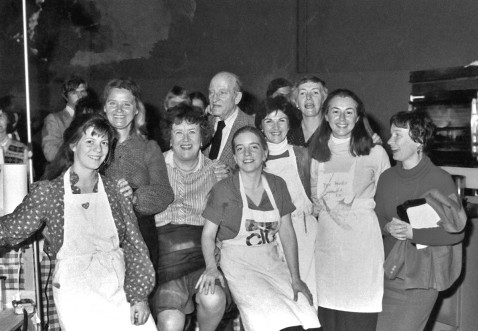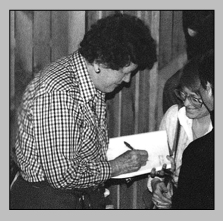Backstage with Julia (5 page)
Read Backstage with Julia Online
Authors: Nancy Verde Barr

As lunchtime approached, I found myself wondering if my mother's chowder was really as delicious as I thought. Too late to do anything about it. Volunteers had set up a long table with china, silver, linens, and an empty space for the large pot of soup that my mother was, at that very moment, carrying down the aisle. Rhode Island has three native chowders: a clear broth with clams and potatoes, a creamy white chowder usually called New England clam chowder, and a red one, which, since there are no carrots, celery, or herbs, is not at all like Manhattan clam chowder. Our Rhode Island version is made with salt pork, both quahogs and clams, tomatoes, and potatoes and served with a pitcher of hot milk and pilot crackers.
1
1
â
4
quarts hard-shelled clams, combination of quahogs and cherrystones, scrubbed
1
â
8
pound salt pork, diced
1 large onion, finely chopped
6 large russet potatoes, peeled, cut into
1
â
4
-inch cubes
6 to 8 large ripe garden tomatoes, finely chopped, or one 28-ounce can Italian peeled plum tomatoes, drained and finely chopped
Salt and ground black pepper, as needed
For serving:
Pitcher of warm milk
Pilot crackers
1.
Bring 2 cups of water to a boil in a deep pot. Add the quahogs, cover and cook for 5 minutes. Stir in cherrystone clams and continue to cook for 5 to 10 minutes or until the shells open. Remove all the clams with a slotted spoon and set aside. Strain the broth twice through a fine-mesh sieve or paper coffee filters. There should be about 1 quart of broth; if not add warm water.
2.
Render the salt pork in a large soup pot and when the fat melts, stir in the onions. Cook over medium-low heat until the onions are translucent and soft; do not let brown. Add the potatoes, tomatoes and broth and bring to a boil, then reduce the heat and simmer about 20 minutes or until the potatoes are tender. Meanwhile, finely mince the quahogs and coarsely chop the cherrystone clams. When the potatoes are tender, stir all the clams into the chowder just to reheat, about a minute. Season with pepper and taste for salt though none should be needed. Serve the chowder with the pitcher of warm milk and pilot crackers.
Note: Quahogs or quahaugs give chowder great flavor, but they are tough so be sure to chop them very fine. My grandmother put them through a meat grinder, and my mother pulsed them in a food processor.
Julia stepped down from the stage to greet my mother, Billie Higgins Verde, who was beaming. My mother was Irish, and her family's foodâprimarily corned beef and cabbage and codfish balls served with homemade baked beans on Sunday morningsâtook a lot of ribbing from my Italian father's family. For her to serve her Irish family's chowder and not lasagna to Julia Child was a real coupâmore so when Julia asked for a second bowl.
That evening, the demonstration began as it had the day before, with much applause and cheering. In spite of the elaborate menu, it was, so to speak, Child's play for Julia. She whipped through cloaking the fish, spinning the caramel, raffling off the finished dishes, and auctioning off the stage equipment.
But there was more. As I would come to know, a Julia show is not over when the Julia show is over. There were fans to greet, books and aprons to sign, and photos to be taken. Julia left the stage and sat at a table facing long lines of admirers waiting for autographs and a word with her. Some approached her laden with an entire collection of Julia Child cookbooks; others held only the program from the demonstration or an apron they had hastily purchased. They lingered, telling Julia how she'd changed their culinary lives, recounting tales of their own kitchen disasters, sharing family recipes, asking Julia what was her favorite recipe, favorite restaurant, favorite anything. Julia listened attentively, commented graciously, and answered all questions except those about favorites. "That's a media-type question," she'd say with her index finger raised. "I don't answer those."

It was taking a long time after an already long day. When one man babbled on, giving a cup-by-tablespoon description of his great-aunt Ethel's orange cake, I was ready to scream. Julia asked him what kind of baking pan Great-aunt Ethel used. Where did she get the energy?
At last, with all the books signed and the last fan satisfied, Julia gathered the kitchen teams together for a group photo.
"Say cheese," the photographer instructed.
"No. Say souf-
flé
," Julia corrected, overstressing the second syllable.
"Soufflé?" I asked, wondering if Julia had randomly chosen a French word. Could we just as readily say
quiche
or
canard
?
Liz, Marian, Ruth, Sara, Paul, and of course Julia were probably hoping someone would ask because, practically in unison, they looked at me, raised their voices, and said "Souf-
flé
! See? You have to smile to say it right."
We smiled our "souf-
flé
" together and then sadly said goodbye.

A few months later Liz Bishop telephoned me. I wasn't surprised to hear from her, since we'd made a nice connection when she was in Providence and had promised to stay in touch. She invited me to Boston, to lunch with Julia, and Julia had a question that did surprise me. Marian was working on a second book, was involved with her own television show, and had a growing family that needed more of her time, so she could not commit to all the work Julia needed. Was I available to work with the Julia team? And, just like that, I hopped on Julia's cart. I would be saying "souf-
flé
" with her for the next twenty-four years.
Chapter 2

Look with favor upon a bold beginning.
âVirgil, Eclogues
My first assignment as a member of the Julia team was to assist her on
Good Morning America
, ABC television's morning news and variety show. Once a month, Julia spent two days at
GMA
's New York City studios. Mondays were for prepping, and Tuesday mornings she appeared live for a cooking spot that ran two and a half or three and a half minutes. When the show went off the air at nine o'clock, she taped four or five segments of the same length for later airing.
Good Morning America
was Julia's first contractual commitment with commercial television. Her primary loyalty would always remain with public television, but she felt snubbed when New York public television failed to air her series
Julia Child
&
More Company.
Astutely aware of the importance of "being out there," she wanted exposure in the city. As she put it, "If you're not on in New York, you ain't nowhere." So
Good Morning America
became her "somewhere" network home.
Several weeks before my first day on the Julia job, she called to give me my instructions.
"Meet us at the studios Monday at 6:00 a.m. sharp. Liz, Sara, and Paul will be there. We'll do a lovely pear tart for the live show." She then described what she would make for the taped shows and, almost as an afterthought, added, "That evening we'll be doing a demonstration for a school called De Gustibus." De Gustibus is now housed in a fully equipped kitchen on the eighth floor of Macy's, but in those days it operated in an auditorium, with all the limitations we'd faced at the RISD auditorium in Providence. "Very jolly people," Julia told me. "I think we'll make paella and a nice sabayon for dessert. Everyone's supposed to get a taste, and I think those dishes will go around nicely."
"How many people do they expect to attend?"
"About three hundred."
I was glad we were on the phone so she couldn't see my it's-never-gonna-happen expression. "That's a lot of people to feed. What kind of stove and equipment do they have?"
"No stove. Not much equipment. I've asked for two electric woks and a hot plate."
If it had been anyone other than Julia, my response would have been,
What? Are you crazy?
As it was, I mustered just enough confidence to say, "That should work."
"Sara will be our executive chef for the TV, but she can't be at the demonstration, so you're in charge. Can you find a good, reliable person in New York to help out?"
The answer came to me immediately. "My good friend Mary Higgins is the assistant food editor at
Ladies' Home Journal
. I'm sure she'd love to do it."
"That's wonderful. I think we should ask her to buy the shrimp for the paella. Oh, and dearie . . ."
"Will you bring six perfect pears to the television set with you?"
I really wished she hadn't said
perfect
. Were perfect pears the same thing to me as they were to Julia? Certainly I'd bought my share of pears, but when Julia Child asks not just for pears but for "perfect pears," they cease to be produce. They are an aptitude test, graduate exams, the law boards. I knew I could spot perfection in pears, but would they be at the right stage of ripeness and still unblemished on the day they had to appear on television?
I took no chances. Every day for a week before the show, I bought pearsâfirm, unblemished Bartlett pears. I stored some in a bowl on the counter âmy usual ripening methodâand some in paper bags, a system I had read about in a cooking magazine. I needed them to be ripe but not too ripe, and I wondered what I would do if they all turned to brown blobs of mush by the time I needed them or, equally disastrous, did not ripen at all in time for the show. I thought about an incident when Philip was an undergraduate and had to evaluate the effects that environmental changes had on Venus flytraps. He had waited too long to buy the plants and there was not enough time to assess the consequences of long exposure to sun and heat. To speed the process he put the plants in the oven, but he wound up killing them all. I rejected the oven as a ripening option.
The counter did the trick, and the night before the show, I stayed at the upper Park Avenue apartment of my college roommate, Jane Andrews, and kept my perfect, precious fruit in my room lest one of her two children mistake them for a late night snack.
Early the next morning, cradling my pears, I prepared to leave Jane's. After assuring me that I would have no trouble finding a taxi at that early hour, she gave me some sound advice.
"This is a valuable experience," she told me. "Notice everything and write it down." Unfortunately, I did not heed her counsel; after all, it was Jane who in college had suggested that we climb out the dorm window after curfew to go get a pizza. And in eighth grade it was she who'd suggested that we skip school and go see
Marjorie Morningstar.
On both occasions she'd assured me, "It will be just fine." It wasn't!
Out on the early-morning street, which was quiet for New York, I worried a taxi into appearing immediately and gave the driver the West Side address of the
Good Morning America
studios, across town. I checked the address several times during the ride to be sure I had it right. When he pulled up to the very ordinary-looking side door across the street from Café des Artistes, I checked it again. Yep. That was it.
